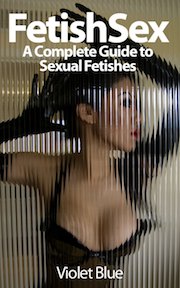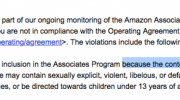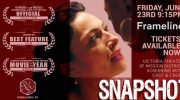The clinical psychologist who performed the largest empirical study on BDSM practitioners has read Fifty Shades of Grey, and concludes that it is a problem. The doctor’s op-ed just hit the pages of the Sydney Morning Herald and it’s being circulated widely.
I know a lot of good people – and many educators – that are posting the fuck out of Fifty Shades of Grey giving bondage a bad name right now. This must-read is an epic smackdown explaining why 50 Shades is not only inaccurate, but that it demonstrates dangerous BDSM practices and distorted, harmful stereotypes about BDSM – and more.
 The author of this op-ed is pretty straight, which – to me – gives Dr. Pamela Stephenson Connolly’s takedown extra weight. Connolly, “carried out an extensive psychological study of people in the BDSM community – the largest empirical study ever done at the time – to examine their psychological attributes and determine if there was any justification for the notion, commonly held, even within my field, that they were all psychologically disturbed.” The full study was published in the Journal of Psychology and Human Sexuality in 2006. She’s got some serious things to say about 50 Shades.
The author of this op-ed is pretty straight, which – to me – gives Dr. Pamela Stephenson Connolly’s takedown extra weight. Connolly, “carried out an extensive psychological study of people in the BDSM community – the largest empirical study ever done at the time – to examine their psychological attributes and determine if there was any justification for the notion, commonly held, even within my field, that they were all psychologically disturbed.” The full study was published in the Journal of Psychology and Human Sexuality in 2006. She’s got some serious things to say about 50 Shades.
I have to say I agree with her 100%.
Snip from Fifty Shades of Grey giving bondage a bad name:
(…) But, most annoyingly, the story demonises BDSM – the term for the erotic style comprising bondage, domination, and sado-masochism – and those who enjoy it. The male protagonist, Christian Grey, is portrayed as a cold-hearted sexual predator with a dungeon (that word has been wisely swapped for “playroom”), full of scary sex toys. Worst of all is the implication that his particular erotic style has developed because he is psychologically “sick”.
Frankly, in BDSM terms, Grey is a lightweight. He eschews many fairly standard interests, although he is an expert at the “mindf—“. Even novices, however, would know that his use of cable ties is a very bad idea (…)
(…) All the work that has been done to establish that BDSM is not a pathological symptom, but one of a wide range of normative human erotic interests, is in danger of being undermined by the success of Fifty Shades. (…read more, smh.com.au, thanks John!)
There’s so much responsible and hot BDSM romance out there, dear readers. Such a shame that this one was the breakthrough.





I hate this book for so many reasons. It’s badly written and has the same problem as Twilight. Cardboard cutout characters.
But, I despise it for the BDSM aspect. I write in this genre as well, and I’ve no first hand knowledge either. BUT, I research the heck out of it to find out exactly what can happen, why it happens and what not to do! The first thing I ever learnt was SSC. Safe, Sane and Consensual. Not to mention that on the news this week they did a story, all be it a short one, on how adult toys have become more popular because of this book.
Those people don’t know any more about BDSM than the author of this book and no one reads those silly A/N’s about how it’s just a story and not supposed to accurately portray BDSM. Look, if I pick up a BDSM book I expect the author to have done some research. It’s like writing a western and getting all sorts of historical details wrong. Or other historic fiction. You can’t get away fudging details that actually are important.
This series is disgusting. I wish it’d never gotten popular. It’s not art, and it’s not literature and it boggles my mind why people even read this. Heck, I didn’t even know it had erotica in it. Which begs the question about how many Twilight kids picked up this book because they heard it was based on a fic in their fandom and then read stuff they’re probably too young to read anyway? HELLO, did anyone think to put a warning on this book?
So I just had to shut a former lover down because he decided that sprinkling in words like “subs”, “spanking” and ownership related comments would be OK in his dialogue with me. Come to find out he has been reading 50 Shades of Wet Crud. Ugh! Unwittingly EL James has done a lot of damage to a community I love and respect. What are we going to do about it?
What I like about the book is that they set a great of example of how couples should actually TALK about their own sex lives. Since they spend so much time negotiating the kink, it forces them to actually have a grown up conversation about their sex lives. And, I love that it does give people who want to be monogamous HOPE that they can have a very inspired and hot, kinky monogamous sexual life.
Thankfully, there are authors who do care and do write accurate non-fiction about how to incorprate kinky practices into your sex life. But, this fanfaction Twilight-esque is just that. Fan fiction and mediocre at best. But, I can tell you from talking to “regular people” who identify as STRAIGHT couples and who are in LTR’s are having sex again and actually talking to their spouses or ltr partners again about how to kink up or just perk up their sex life and for that I am grateful. Most couples RARELY talk about their own sex life until someone cheats or someone has ED.
EL could have REALLY used an editor or someone like Violet to consult with her.
Let’s all campaign that VB is the BDSM and FETISH consultant when the screenplay is written and the movie is made. PLEASE – they need some help!
The sad part is that there IS Twilight fanficiton that’s heavily BDSM themed. It’s called “The Submissive.” The characters all have jobs, families and interests outside their sex lives. I can’t speak as to whether the BDSM in it is accurate, but issues of safety, preparation and control feature heavily.
I think Dr. Connelly’s piece was originally published in The Guardian newspaper in London, and was taken off the wire by the SMH. Dr Connelly is the Guardian’s resident sex columnist and voice of reason.
she is a bit of a celeb in England, having been an actress and comedian before training as a sex therapist, and being married to comedian Billy Connelly. She also appeared on the British version of Dancing with the Stars, but don’t hold that against her.
It bothers me to talk about 50 shades at all. I am still trying to plow my way through it so take this with more than a grain of salt. I write erotica and I also write horror. Some of the stories I tell are not supposed to be safe or duplicated. In these cases, it’s often a warning of authority in the wrong hands.
Apparently, James has said she has no firsthand knowledge of BDSM. Yes, that is apparent. I can forgive a bit of recklessness on her part for that, I know nothing of killing someone with my bare hands, but I may choose to write about it.
I remember the fury about Harry Potter being used as a manual for children to try witchcraft. This was as unsuccessful as I imagine using 50 Shades as a manual to be. Anyone that attempts to duplicate BDSM with the advice of this book will soon find that it isn’t for them. Without the *substance* of the lifestyle, the trappings are simply so much pain and irritation.
I cannot fault the author for her misunderstanding of the lifestyle. I find It interesting that she put it in that context, almost like teenagers trying to imagine what it’s like to “be with a boy”.
I have never criticized the writing either, not everyone can or should write, but if it’s a hobby or fun for her, then I support that and congratulate her for being in the right place at the right time with the accidentally right book.
I feel despondent however when bad writing is expected in erotica and legions of fans will rabidly defend what they freely admit is poor writing. Books like this are why erotica is held to such a low standard.
Thanks for responding, Violet, and hi! I like all your things!
First, if a book is a manual or how-to guide of some sort, sure– it should be accurate.
But so much of erotica is fantasy. And fantasy jumps the line between feasible and not feasible rather easily. Yes, we can tweak our stories to make sure they are within the realm of SSC (Safe, Sane, Consensual). But is it our inherent duty to do this? Absolutely not.
As an author, I can say, “Sadey Quinn portrays all sexual scenarios in a way that could be replicated in your own bedroom by your own beautiful self!”. Or I can skip that, and do what I want to do. For the record, I do put a little disclaimer note in my books for the blah blah warnings etc etc adults only wordage. And for another record, my stuff is fairly… able to be replicated… The point is, it’s not an obligation. It isn’t in some author moral code.
I have done ridiculous things to make sure my stories are accurate and portray situations that could actually occur… to the point of tying myself up to make sure a certain move can be done with unique types of constraints… and to the point of doing wall-sits (!)… and other crazy shit. So, that said, I’m all for accuracy– but not for ethical reasons. I just think it would be distracting if a reader had to stop and say, ‘Wait… is that even possible?’
Second, I read the 50 Shades books and, besides the psychological fucked-up-ness portrayed regarding Christian Grey, I actually didn’t see anything ‘dangerous’ or whatever about the BDSM practiced. It was a really, really tame series. Was I annoyed that the Dom was portrayed as being a Dom purely because of psychological problems? Yeah. That’s annoying, but it’s a common theme in BDSM stuff. The popular movie Secretary is like that, along with a number of more modern BDSM erotica novels/stories.
Perhaps the critique above is purely about the psychological elements; if that’s so, I could come up with a huge slew of titles to throw out that are not related to BDSM but certainly touch on messed up psyches. And maybe those authors should issue a disclaimer, too? ‘This book is about a person who is not psychologically well. Please be sure you don’t jump off a bridge, like he does, on page 230. And also, don’t cook lentils the way his wife does. She overcooks them, because she’s so distracted by her husband’s fucked up brain. Just be careful. And turn off the stove. And check your CO2 detector. Also, smoking is bad for your health, so just because this character smokes, don’t go ahead and do that. You have been warned, sign below.’
When Ms James wrote 50 Shades, she wasn’t standing up to defend or portray BDSM in a way that the BDSM community would like. Her agenda was simple: write a book, make some money, have some fun doing it. In the same way that my gay friend doesn’t stand up to ‘represent gayness’ as he makes his way through his daily life, and my black friend doesn’t ‘represent blackness’ as she walks around downtown; E.L James does NOT represent BDSM just because she practices it (which I don’t know that she does) or just because she wrote some books that included BDSM as a theme.
I’m not defending the writing or the books. Frankly, I’d rather see articles critiquing the writing style than criticisms about Ms James’ supposed ethical breaches against the BDSM community. This isn’t about whether 50 Shades is art. Let’s focus on the readers, instead, and figure out a way that they can get involved and be a part of recognizing that books are books, people are people, and life is life. Reality doesn’t happen on pages.
I guess one thing we can likely agree on is that erotica authors have a challenge, now. Rather than bitch or think about how 50 Shades is so annoyingly useless in a variety of ways, we can write. And we can do better. We *have* done better. I firmly believe that if we can keep the content rich and good, the entire 50 Shades phenomenon will actually help erotic lit grow to be an even more popular genre.
cheers, Violet! :)Sadey
Sadey, I’d like to respond. Thank you so much for your comment.
I’m of two minds in regard to author (and editor) responsibility to the reader.
I personally believe that yes: it is the author and editor’s responsibility in the relationship to their readers to portray accuracy – and hopefully safety – in their works. I have based every single one of my books and held all of the several hundreds of authors I’ve worked with over the years to this standard. My rules are it must be realistic, and it must be safe and consensual – and if it’s an outrageous fantasy, it must be contextual to these rules. I have stories in my collections with guns, gangbangs, abductions, and much more edgy content – and in each one. I have guided the writer to include the consent and safety context to keep the fantasy real and hot. It has never interfered with the fantasy, and is an easy thing to do. All work with my name on it can be tried at home. And many erotic authors adhere to this – Alison Tyler comes to mind.
But – that’s just me. I think 50 Shades could have easily been tweaked to be safe and hot – by simply making itself *realistic* and still a crazy-hot fantasy.
At the same time, I feel very strongly in standing up for works like Emmanuelle, Story of O, and works by Marquis de Sade and A.N. Rolquiere. They are by no means safe or realistic, yet they should be both protected as art and allowed to have license because they are art.
But no one will argue this: 50 Shades is not art.
Nor is it responsible enough to have a page that explains that what’s in the book isn’t safe, or its stereotypes realistic pictures of people that do BDSM, and that if people want to find out more they can go to X websites and read X books. It wouldn’t cost anything, being that ebooks don’t have printing overheads and can be easily changed and updated.
So, like it or hate it, the book is not just a story. Not anymore, anyway. This could be an opportunity to say something meaningful, if it were in the right hands.
This gets into a serious ethical dilemma for authors: Is it the author’s responsibility to accurately and ‘safely’ portray a concept within their fiction book?
I kinda gotta side with EL James on this one. When Ms James sat down to write 50 Shades, she wasn’t setting herself up to accurately describe BDSM to a vanilla group of people. She was simply writing a story.
Whether or not you like the story? Not important. With any book that goes this viral, people will both love and hate it…
I don’t like a lot of the BDSM erotica that’s out there. Some people say mine sucks; others say it’s accurate (it’s not, or it would be boring, but it’s decent).
But accusing an author of being harmful because she wrote fiction? OK, let’s start blaming the people who wrote the Bible for the countless amounts of hateful crimes committed in the name of ‘God’. Let’s start blaming de Sade for people who take sadism to the unethical extreme…
Or… we could put the responsibility of interpretation and investigation into the hands of the readers. Which seems to me the logical course of action.
This is a two sided coin. On the one hand, Fifty Shades is obviously not written to educate but instead to entertain and sell books. That said, an entirely vanilla woman friend approached me this weekend about how she could get involved after reading Fifty Shades. I referred her to a local group that will give her a good basic 101 and where she can explore and be reasonably safe. So while the books are misleading, they are still opening a lot of minds and hearts to the possibilities.
Ironically, Thursday night Showtime’s new reality series, “Polyamory: Married and Dating” debuts. Again, its purpose is not to educate (at least not as far as Showtime is likely concerned) but to entertain viewers and make money for Showtime. The people involved are good, articulate, and attractive. The sex might be quite hot, we’ll see. With an 11PM time slot and from the previews, it looks like there will be a lot of it. But they are also people who some expect have demonstrated a deep commitment to tantric sex as a spiritual path as a central feature of the story. Some in the polyamory leadership world are less than pleased at this pairing as the first broad audience example of polyamory and believe that mainstreamers will be given the impression that poly people are new age California wackos. Yet surely this series will open a lot of eyes to the possibilities.
If only we could write the books and the scripts in accordance with what we know is ethical, accurate, and all encompassing as to example and truth! Alt sex advocacy is certainly messy stuff, but I am optimistic that these cultural emergences will ultimately serve our purposes, however many misconceptions we end up having to correct.
I am starting to think the root dilemma is that to really go mainstream, a BDSM text has to tap the audience of people who are aroused by BDSM but also judgmental of it. Consider the “girls gone wild” lesbiana of the fifties — it made homosexuality out to be both bad *and* erotic. It’s an end-run around internalized shame to be even considering such things — the old evangelical “Just LOOK at all this HORRIBLE PORN!” maneuver. Arguably if 50 Shades painted a healthier picture, it would not be nearly as popular, because it would be *more* confronting.
While there are many issues that can validly be stated with the “50 Shades” series, many of which I have mentioned in my own Blog, specifically its association with previous early abuse, and it’s continued reference to how Grey can know what is in the mind of Ana without her having to communicate it. (A bad assumption within any relationship, I also found several areas which are advantages to members of the lifestyle.
The most obvious one is that, detrimental or not, it is being widely talked about, the subject is out there, people who would strongly identify with “Vanilla” are discussing it and possibly finding themselves a touch more open to opinions which are not so strongly conservative as far as sexual experimentation.
Another issue of importance is that consistently in the series is the emphasis of consent. While the two major players come from widely divergent backgrounds and sexual attitudes and some humorous comments have been made about the early introduction of the “contract”, I found the continued emphasis from Grey on the informed consent from Ana something refreshing and necessary.
Finally two assides. The first being I believe I was one of the original participants of Dr. Connolly’s original study 10 years ago. The second is I am now reading a delightful book on Fetishes, written by, ah….guess who. Nice work, dear Lady.